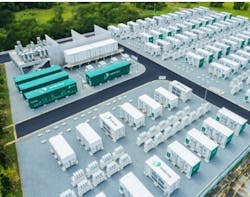Southeast Asia’s largest Energy Storage project deployed at Singapore island
Singapore-based energy and urban development company Sembcorp Industries has officially opened the 285-MWh utility-scale energy storage system (ESS) on the country’s Jurong Island.
According to the company, the Sembcorp ESS, commissioned in December 2022, is Southeast Asia’s largest ESS and the fastest to be deployed globally of its size.
Sembcorp was selected by Energy Market Authority (EMA), a statutory board under the Singapore Ministry of Trade and Industry, to develop the facility on two hectares of land in the Banyan and Sakra region of Jurong Island in June 2022.
China Energy Engineering Group Shanxi Electric Power Engineering Co. oversaw the engineering, procurement, construction, infrastructure works, manpower training, installation and commissioning of the Sembcorp ESS.
With a maximum storage capacity of 285 MWh, the energy storage system can provide power to around 24,000 four-room households for a day in a single discharge. Its quick response time helps mitigate solar intermittency and enhances power grid stability by managing mismatches between electricity demand and supply, the company says.
The system is also designed to provide reserves to the power grid, thereby freeing up power generation plants to produce more electricity to meet demand, when needed.
The ESS comprises more than 800 large-scale battery units and uses lithium iron phosphate batteries with fast response times and high energy density for optimal energy storage. The system is monitored through the use of intelligent sensors and security cameras to ensure safe and reliable performance.
A central control system regulates the batteries’ charge and discharge cycles based on to grid’s supply and demand. The system also includes liquid cooling systems or built-in air conditioning systems to maintain optimal operating temperatures.
The Sembcorp ESS uses Envision’s energy management system and Supervisory Control and Data Acquisition platform for monitoring and control of the ESS, while Huawei’s battery systems help maintain optimal temperatures for stable power output.
“ESS is rapidly growing in demand, to support power system reliability, especially for the integration of intermittent renewable energy,” Wong Kim Yin, Group President & CEO of Sembcorp Industries, said. “Sembcorp already operates one of the largest fleets of ESS in the UK. This 285 MWh ESS is the largest in Southeast Asia. At 709 MWh, Sembcorp is now one of Asia’s largest and fastest-growing ESS operators with strong technical capabilities.”
EMA's ACCESS programme promotes ESS adoption in Singapore by promoting use cases and business models with industry partners and other government agencies.
About the Author
EnergyTech Staff
Rod Walton is senior editor for EnergyTech.com. He has spent 17 years covering the energy industry as a newspaper and trade journalist.
Walton formerly was energy writer and business editor at the Tulsa World. Later, he spent six years covering the electricity power sector for Pennwell and Clarion Events. He joined Endeavor and EnergyTech in November 2021.
He can be reached at [email protected].
EnergyTech is focused on the mission critical and large-scale energy users and their sustainability and resiliency goals. These include the commercial and industrial sectors, as well as the military, universities, data centers and microgrids.
Many large-scale energy users such as Fortune 500 companies, and mission-critical users such as military bases, universities, healthcare facilities, public safety and data centers, shifting their energy priorities to reach net-zero carbon goals within the coming decades. These include plans for renewable energy power purchase agreements, but also on-site resiliency projects such as microgrids, combined heat and power, rooftop solar, energy storage, digitalization and building efficiency upgrades.
